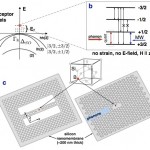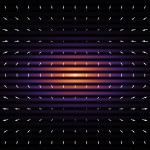All
January 25th, 2013 | by
admin | published in
All, Blog, Preprints, Quantum Computing

We review and expand on previous work that treats relaxation physics of low-lying excited states in ideal, single electron, silicon quantum dots in the context of quantum computing. These states are of three types: orbital, valley, and spin. The relaxation times depend sensitively on system parameters such as the dot size and the external magnetic […]
September 20th, 2012 | by
admin | published in
All, News, Preprints

Sound can be just as quantum as light. But our toolbox for single quanta of sound, i.e. phonons, is currently insufficient. Here we describe a new component that enables a chip-based, solid-state analogue of cavity-QED utilizing acoustic phonons instead of photons, phonitons instead of polaritons. We show how long-lived and tunable acceptor (hole) impurity states […]
August 14th, 2012 | by
admin | published in
All, Blog, Press

The science of how light interacts with matter is called quantum electrodynamics or QED and the theory on which it is based is one of the crowning achievements of 20th century physics.
Today, it lies at the heart of an emerging technology called circuit-QED, in which photons trapped on a silicon chip are made to interact with superconducting devices called artificial atoms, which have various energy levels just like real atoms.
This is a promising tool for quantum computation. Circuit-QED devices manipulate quantum information as it is transferred from light to matter and vice versa. And the fact that this all takes place on a single chip allows unprecedented control.
But there is another way of doing this kind of quantum information processing that could be just as promising. Instead of relying on light, this uses quantum packets of sound called phonons.
April 17th, 2012 | by
admin | published in
All, News, Phonitons
Could the Next World-Changing Technology Emerge From UMD? (Not exactly how we would hype it, but we appreciate the support!) Phonitons as a Sound-based Analogue of Cavity Quantum Electrodynamics Charles George Tahan, Rousko Todorov Hristov, Oney O. Soykal Researchers at the University of Maryland and the National Security Agency (NSA) have developed the analog of […]
December 2nd, 2011 | by
admin | published in
All, Blog, Press
Condensed-matter physicists have their own particle zoo – a menagerie filled with familiar and exotic quasiparticles including old favourites like holes and phonons, and newer additions such as surface plasma polaritons. Quasiparticles are excitations in a solid that behave like tiny particles and obey quantum mechanics. A phonon for example, is a quantized sound wave that propagates through a crystal.
Now Charles Tahan and colleagues at the Laboratory for Physical Sciences just outside Washington, DC have shown that the interaction between phonons and electronic excitations in certain semiconductors can be described in terms of a brand new quasiparticle called the phoniton.
November 28th, 2011 | by
admin | published in
All, Blog, Press
Theorists propose an experiment to observe a “phoniton,” a novel hybrid of an electron and a quantum of vibration in a crystal lattice.
Vibrations in a crystal can combine with an electron in a new way to form a hybrid quantum entity, according to a team of theorists publishing in Physical Review Letters. They call it a “phoniton,” a particle that combines a phonon—the quantum form of vibrations—with a matter excitation, such as an electron that transits between two levels. The team also proposes a nanostructure that would support this quantum state and allow it to be observed.
November 28th, 2011 | by
admin | published in
All, Blog, Featured, Highlights, Nanotechnology, Papers, Phonitons, Research

This work explores the possibility of a new, man-made quantum object: a hybridization of a localized, long-lived phonon (a quantum of sound) and a matter excitation. That this is possible is not obvious.
October 29th, 2011 | by
admin | published in
All, Blog, News
“Phononiton” has become “phoniton” by negotiation with the editors of PRL. It’s etymologically cleaner. The good news is that our paper has been accepted for publication in PRL and the new term “phoniton” has been accepted as well. See our summary for more information.
October 6th, 2011 | by
admin | published in
All, Thoughts
Creativity is just connecting things. When you ask creative people how they did something, they feel a little guilty because they didn’t really do it, they just saw something. It seemed obvious to them after a while. When you first start off trying to solve a problem, the first solutions you come up with […]
June 10th, 2011 | by
admin | published in
All, News, Preprints
The progression of quantum technology relies in part on the identification and control of components, such as confined electrons or photons, from which systems of greater complexity are built. Here we describe another potentially valuable component, a composite object formed as a quantum mechanical superposition of a long-lived, localized phonon and a matter excitation: half-sound, half-matter.


